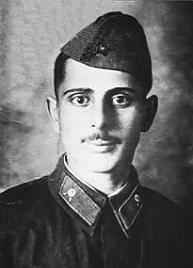
Isai Illazarov
Isai Illazarov was born to a family of Mountain Jews in 1920 in Nalchik (in the Kabardino-Balkar Autonomous Republic in the Northern Caucasus). After graduating from a seven-year general education school, he worked for a short time at a shoe factory. In 1938 Isai Illazarov became a celebrity in the Kabardino-Balkar Republic. Being a good athlete, he trained and then led a group of young people that climbed Mount Elbrus, the highest point in the Northern Caucasus. For this ascent Illazarov was awarded the title of Master of Sports of the USSR He was one of the first holders of this title in the country. However, during this climb, Illazarov he suffered frostbite. This led to a long stay in hospital and an end to his work at the shoe factory. Before the Soviet-German war, he worked as a truck driver for a city bakery. He married in 1940, and in 1941, his first son was born. His second son was born the following year, when Illazarov was already at the front.
On November 2, 1941, Illazarov was drafted into the Red Army, where he was assigned to the infantry and took part in the defense of Moscow. Three weeks later, he destroyed his first enemy tank. Then he was seriously injured and spent a long time in hospital. In the summer of 1942, he fought in the northern Caucasus, where the Red Army was in retreat, and in 1943 – in the Kursk Salient. He was awarded several medals. He was wounded again and returned to active service only in 1944. In June 1944, during the Red Army offensive in Belorussia, his regiment was deployed west of Vitebsk. When his regiment broke through the enemy defense line, Illazarov replaced his company commander, who had been killed, and led the company forward. In hand to hand fighting, he and his men broke succeeded in liberating the village of Kortashi. Illazarov was recommended for the title of Hero of the Soviet Union.
The military authorities consider his case for so long that when Illazarov was finally awarded this title in March 1945, he was no longer alive. He had been killed in September 1944 in Latvia and was buried in a common grave.
Today a street in Nalchik bears his name, as does the Center of Ethnic Cultures that opened in Moscow in 2011.






